The US-China Trade War: Impact on International Business Growth
VerifiedAdded on 2022/12/29
|16
|4217
|38
Report
AI Summary
This report analyzes the impact of the US-China trade war on international businesses, examining the effects of tariffs, supply chain disruptions, and shifts in global competitiveness. It explores how the trade conflict has slowed global trade growth, altered import and export patterns, and affected various industries, including technology, manufacturing, and raw materials. The report highlights the consequences for both the US and China, as well as the broader implications for other countries and multinational corporations. It discusses the imposition of tariffs, the responses from both nations, and the resulting changes in production costs, consumer prices, and supply chain strategies. The report also considers the beneficiaries of the trade war, such as Southeast Asia, and the overall disruption to global supply chains.
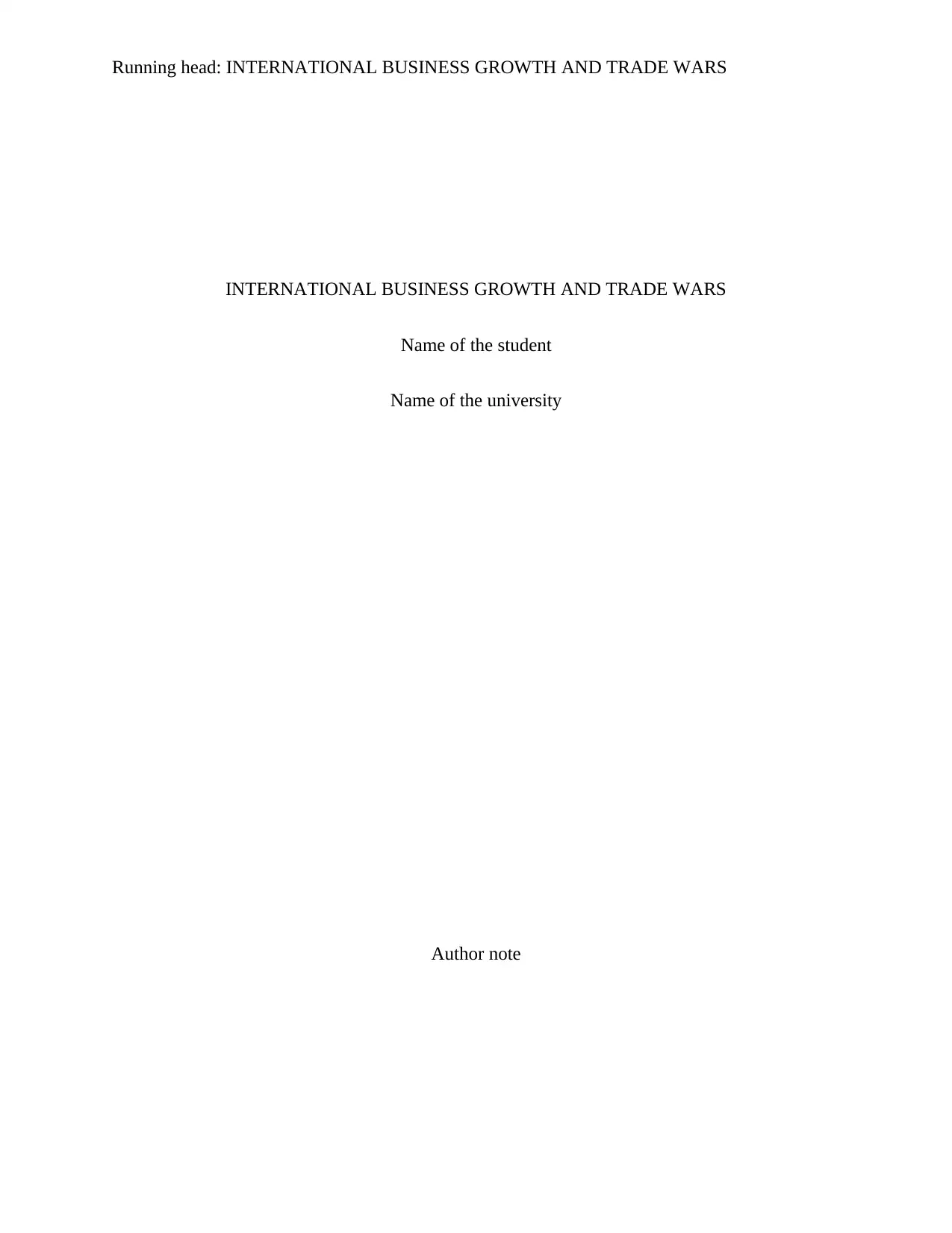
Running head: INTERNATIONAL BUSINESS GROWTH AND TRADE WARS
INTERNATIONAL BUSINESS GROWTH AND TRADE WARS
Name of the student
Name of the university
Author note
INTERNATIONAL BUSINESS GROWTH AND TRADE WARS
Name of the student
Name of the university
Author note
Paraphrase This Document
Need a fresh take? Get an instant paraphrase of this document with our AI Paraphraser
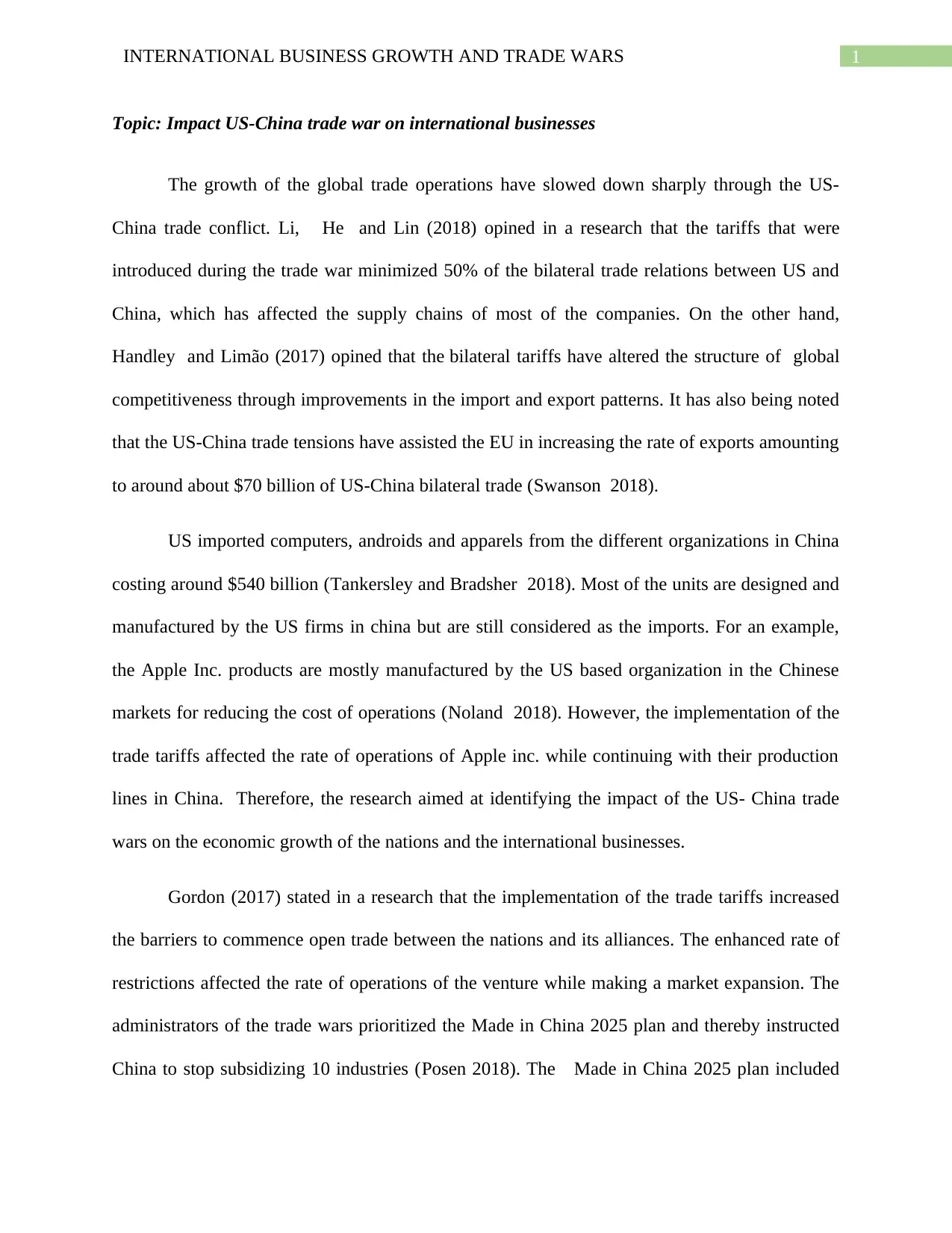
1INTERNATIONAL BUSINESS GROWTH AND TRADE WARS
Topic: Impact US-China trade war on international businesses
The growth of the global trade operations have slowed down sharply through the US-
China trade conflict. Li, He and Lin (2018) opined in a research that the tariffs that were
introduced during the trade war minimized 50% of the bilateral trade relations between US and
China, which has affected the supply chains of most of the companies. On the other hand,
Handley and Limão (2017) opined that the bilateral tariffs have altered the structure of global
competitiveness through improvements in the import and export patterns. It has also being noted
that the US-China trade tensions have assisted the EU in increasing the rate of exports amounting
to around about $70 billion of US-China bilateral trade (Swanson 2018).
US imported computers, androids and apparels from the different organizations in China
costing around $540 billion (Tankersley and Bradsher 2018). Most of the units are designed and
manufactured by the US firms in china but are still considered as the imports. For an example,
the Apple Inc. products are mostly manufactured by the US based organization in the Chinese
markets for reducing the cost of operations (Noland 2018). However, the implementation of the
trade tariffs affected the rate of operations of Apple inc. while continuing with their production
lines in China. Therefore, the research aimed at identifying the impact of the US- China trade
wars on the economic growth of the nations and the international businesses.
Gordon (2017) stated in a research that the implementation of the trade tariffs increased
the barriers to commence open trade between the nations and its alliances. The enhanced rate of
restrictions affected the rate of operations of the venture while making a market expansion. The
administrators of the trade wars prioritized the Made in China 2025 plan and thereby instructed
China to stop subsidizing 10 industries (Posen 2018). The Made in China 2025 plan included
Topic: Impact US-China trade war on international businesses
The growth of the global trade operations have slowed down sharply through the US-
China trade conflict. Li, He and Lin (2018) opined in a research that the tariffs that were
introduced during the trade war minimized 50% of the bilateral trade relations between US and
China, which has affected the supply chains of most of the companies. On the other hand,
Handley and Limão (2017) opined that the bilateral tariffs have altered the structure of global
competitiveness through improvements in the import and export patterns. It has also being noted
that the US-China trade tensions have assisted the EU in increasing the rate of exports amounting
to around about $70 billion of US-China bilateral trade (Swanson 2018).
US imported computers, androids and apparels from the different organizations in China
costing around $540 billion (Tankersley and Bradsher 2018). Most of the units are designed and
manufactured by the US firms in china but are still considered as the imports. For an example,
the Apple Inc. products are mostly manufactured by the US based organization in the Chinese
markets for reducing the cost of operations (Noland 2018). However, the implementation of the
trade tariffs affected the rate of operations of Apple inc. while continuing with their production
lines in China. Therefore, the research aimed at identifying the impact of the US- China trade
wars on the economic growth of the nations and the international businesses.
Gordon (2017) stated in a research that the implementation of the trade tariffs increased
the barriers to commence open trade between the nations and its alliances. The enhanced rate of
restrictions affected the rate of operations of the venture while making a market expansion. The
administrators of the trade wars prioritized the Made in China 2025 plan and thereby instructed
China to stop subsidizing 10 industries (Posen 2018). The Made in China 2025 plan included
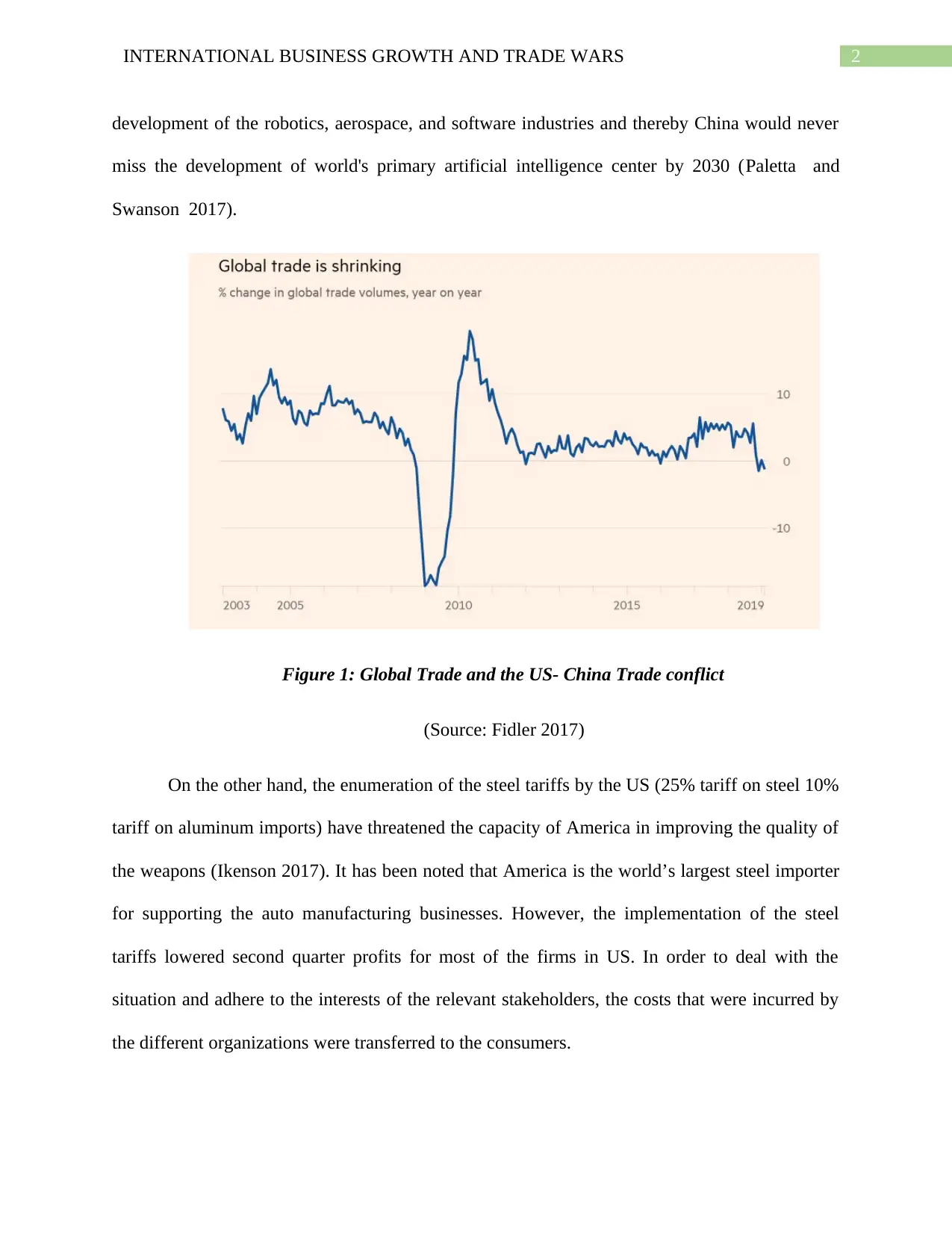
2INTERNATIONAL BUSINESS GROWTH AND TRADE WARS
development of the robotics, aerospace, and software industries and thereby China would never
miss the development of world's primary artificial intelligence center by 2030 (Paletta and
Swanson 2017).
Figure 1: Global Trade and the US- China Trade conflict
(Source: Fidler 2017)
On the other hand, the enumeration of the steel tariffs by the US (25% tariff on steel 10%
tariff on aluminum imports) have threatened the capacity of America in improving the quality of
the weapons (Ikenson 2017). It has been noted that America is the world’s largest steel importer
for supporting the auto manufacturing businesses. However, the implementation of the steel
tariffs lowered second quarter profits for most of the firms in US. In order to deal with the
situation and adhere to the interests of the relevant stakeholders, the costs that were incurred by
the different organizations were transferred to the consumers.
development of the robotics, aerospace, and software industries and thereby China would never
miss the development of world's primary artificial intelligence center by 2030 (Paletta and
Swanson 2017).
Figure 1: Global Trade and the US- China Trade conflict
(Source: Fidler 2017)
On the other hand, the enumeration of the steel tariffs by the US (25% tariff on steel 10%
tariff on aluminum imports) have threatened the capacity of America in improving the quality of
the weapons (Ikenson 2017). It has been noted that America is the world’s largest steel importer
for supporting the auto manufacturing businesses. However, the implementation of the steel
tariffs lowered second quarter profits for most of the firms in US. In order to deal with the
situation and adhere to the interests of the relevant stakeholders, the costs that were incurred by
the different organizations were transferred to the consumers.
⊘ This is a preview!⊘
Do you want full access?
Subscribe today to unlock all pages.

Trusted by 1+ million students worldwide
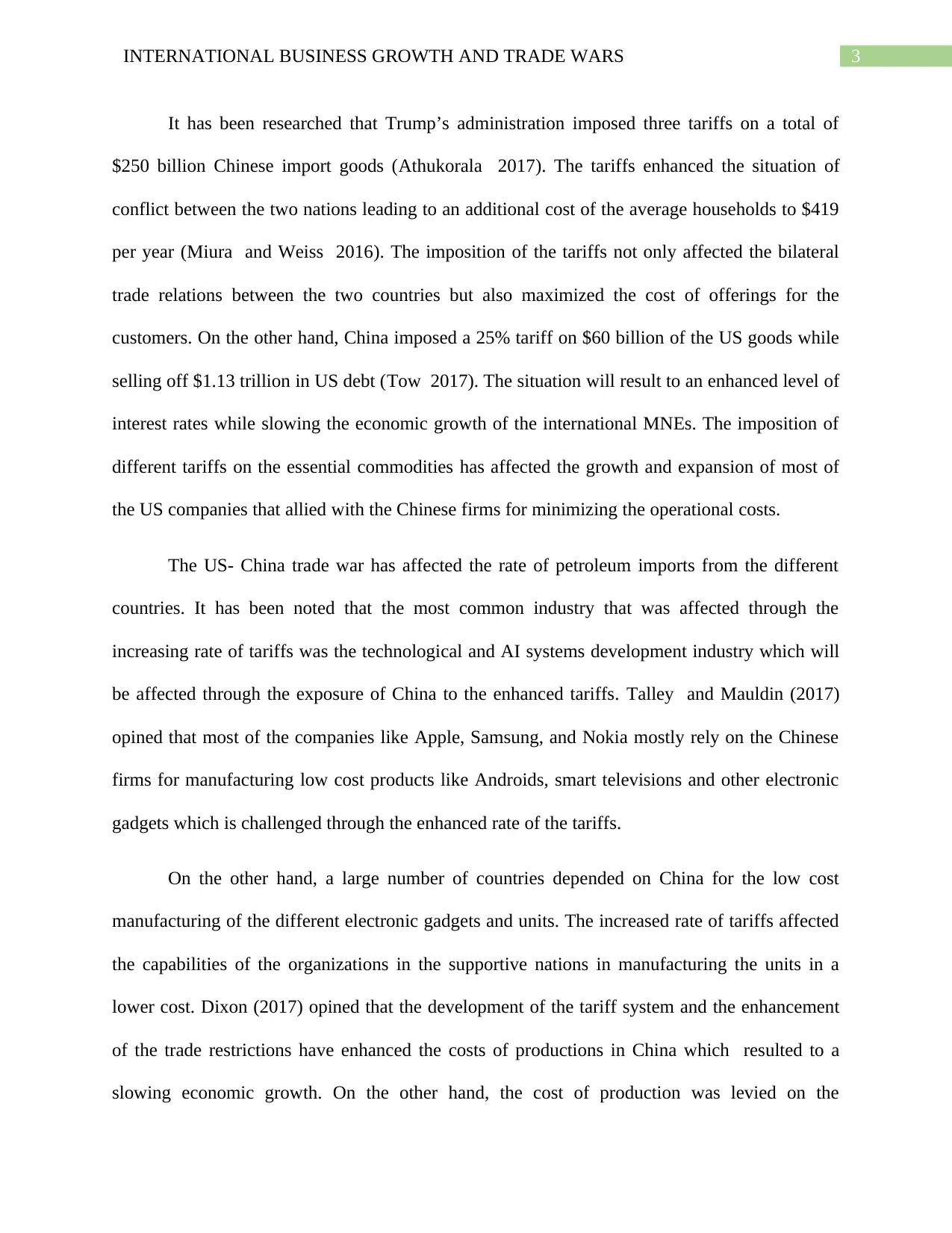
3INTERNATIONAL BUSINESS GROWTH AND TRADE WARS
It has been researched that Trump’s administration imposed three tariffs on a total of
$250 billion Chinese import goods (Athukorala 2017). The tariffs enhanced the situation of
conflict between the two nations leading to an additional cost of the average households to $419
per year (Miura and Weiss 2016). The imposition of the tariffs not only affected the bilateral
trade relations between the two countries but also maximized the cost of offerings for the
customers. On the other hand, China imposed a 25% tariff on $60 billion of the US goods while
selling off $1.13 trillion in US debt (Tow 2017). The situation will result to an enhanced level of
interest rates while slowing the economic growth of the international MNEs. The imposition of
different tariffs on the essential commodities has affected the growth and expansion of most of
the US companies that allied with the Chinese firms for minimizing the operational costs.
The US- China trade war has affected the rate of petroleum imports from the different
countries. It has been noted that the most common industry that was affected through the
increasing rate of tariffs was the technological and AI systems development industry which will
be affected through the exposure of China to the enhanced tariffs. Talley and Mauldin (2017)
opined that most of the companies like Apple, Samsung, and Nokia mostly rely on the Chinese
firms for manufacturing low cost products like Androids, smart televisions and other electronic
gadgets which is challenged through the enhanced rate of the tariffs.
On the other hand, a large number of countries depended on China for the low cost
manufacturing of the different electronic gadgets and units. The increased rate of tariffs affected
the capabilities of the organizations in the supportive nations in manufacturing the units in a
lower cost. Dixon (2017) opined that the development of the tariff system and the enhancement
of the trade restrictions have enhanced the costs of productions in China which resulted to a
slowing economic growth. On the other hand, the cost of production was levied on the
It has been researched that Trump’s administration imposed three tariffs on a total of
$250 billion Chinese import goods (Athukorala 2017). The tariffs enhanced the situation of
conflict between the two nations leading to an additional cost of the average households to $419
per year (Miura and Weiss 2016). The imposition of the tariffs not only affected the bilateral
trade relations between the two countries but also maximized the cost of offerings for the
customers. On the other hand, China imposed a 25% tariff on $60 billion of the US goods while
selling off $1.13 trillion in US debt (Tow 2017). The situation will result to an enhanced level of
interest rates while slowing the economic growth of the international MNEs. The imposition of
different tariffs on the essential commodities has affected the growth and expansion of most of
the US companies that allied with the Chinese firms for minimizing the operational costs.
The US- China trade war has affected the rate of petroleum imports from the different
countries. It has been noted that the most common industry that was affected through the
increasing rate of tariffs was the technological and AI systems development industry which will
be affected through the exposure of China to the enhanced tariffs. Talley and Mauldin (2017)
opined that most of the companies like Apple, Samsung, and Nokia mostly rely on the Chinese
firms for manufacturing low cost products like Androids, smart televisions and other electronic
gadgets which is challenged through the enhanced rate of the tariffs.
On the other hand, a large number of countries depended on China for the low cost
manufacturing of the different electronic gadgets and units. The increased rate of tariffs affected
the capabilities of the organizations in the supportive nations in manufacturing the units in a
lower cost. Dixon (2017) opined that the development of the tariff system and the enhancement
of the trade restrictions have enhanced the costs of productions in China which resulted to a
slowing economic growth. On the other hand, the cost of production was levied on the
Paraphrase This Document
Need a fresh take? Get an instant paraphrase of this document with our AI Paraphraser
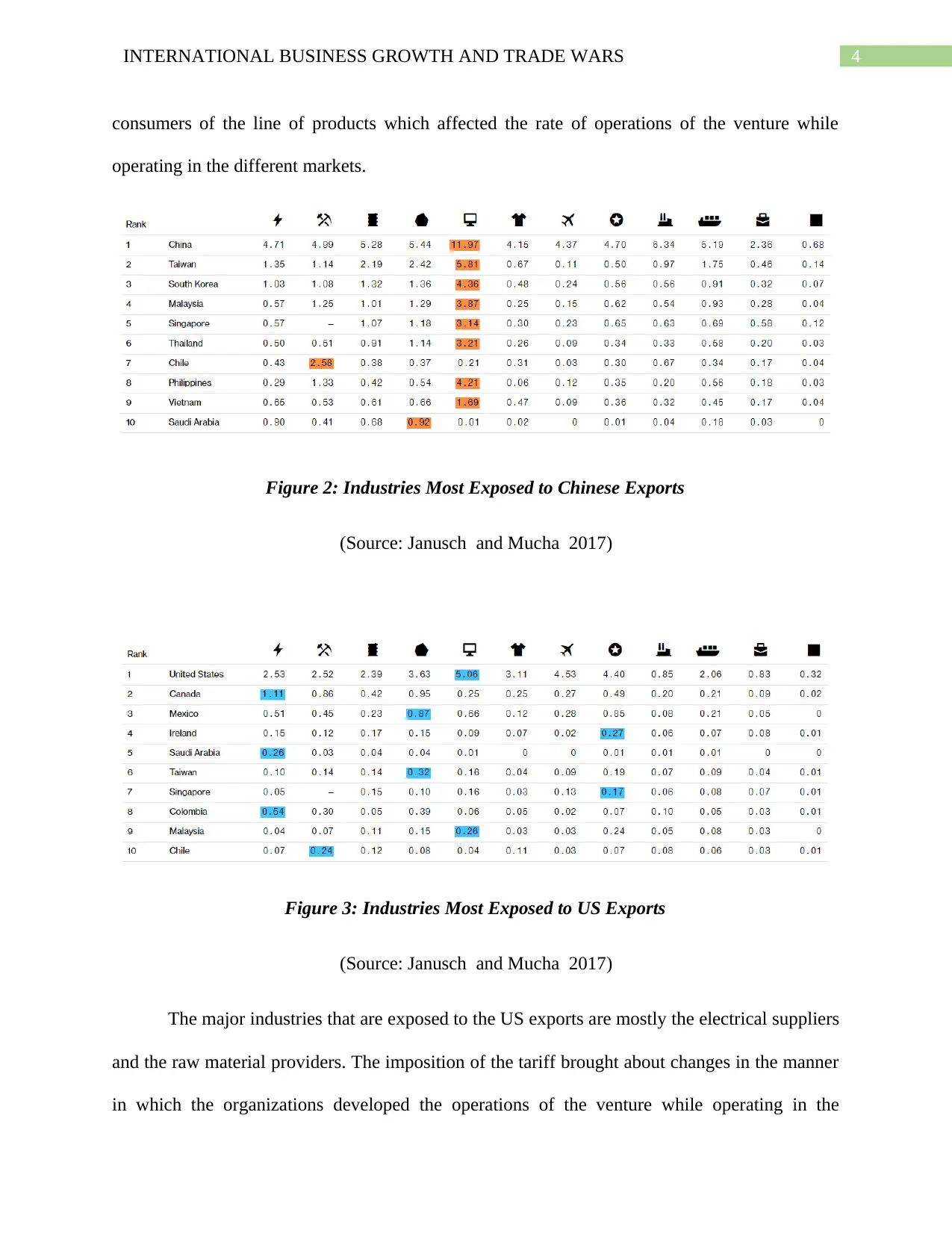
4INTERNATIONAL BUSINESS GROWTH AND TRADE WARS
consumers of the line of products which affected the rate of operations of the venture while
operating in the different markets.
Figure 2: Industries Most Exposed to Chinese Exports
(Source: Janusch and Mucha 2017)
Figure 3: Industries Most Exposed to US Exports
(Source: Janusch and Mucha 2017)
The major industries that are exposed to the US exports are mostly the electrical suppliers
and the raw material providers. The imposition of the tariff brought about changes in the manner
in which the organizations developed the operations of the venture while operating in the
consumers of the line of products which affected the rate of operations of the venture while
operating in the different markets.
Figure 2: Industries Most Exposed to Chinese Exports
(Source: Janusch and Mucha 2017)
Figure 3: Industries Most Exposed to US Exports
(Source: Janusch and Mucha 2017)
The major industries that are exposed to the US exports are mostly the electrical suppliers
and the raw material providers. The imposition of the tariff brought about changes in the manner
in which the organizations developed the operations of the venture while operating in the
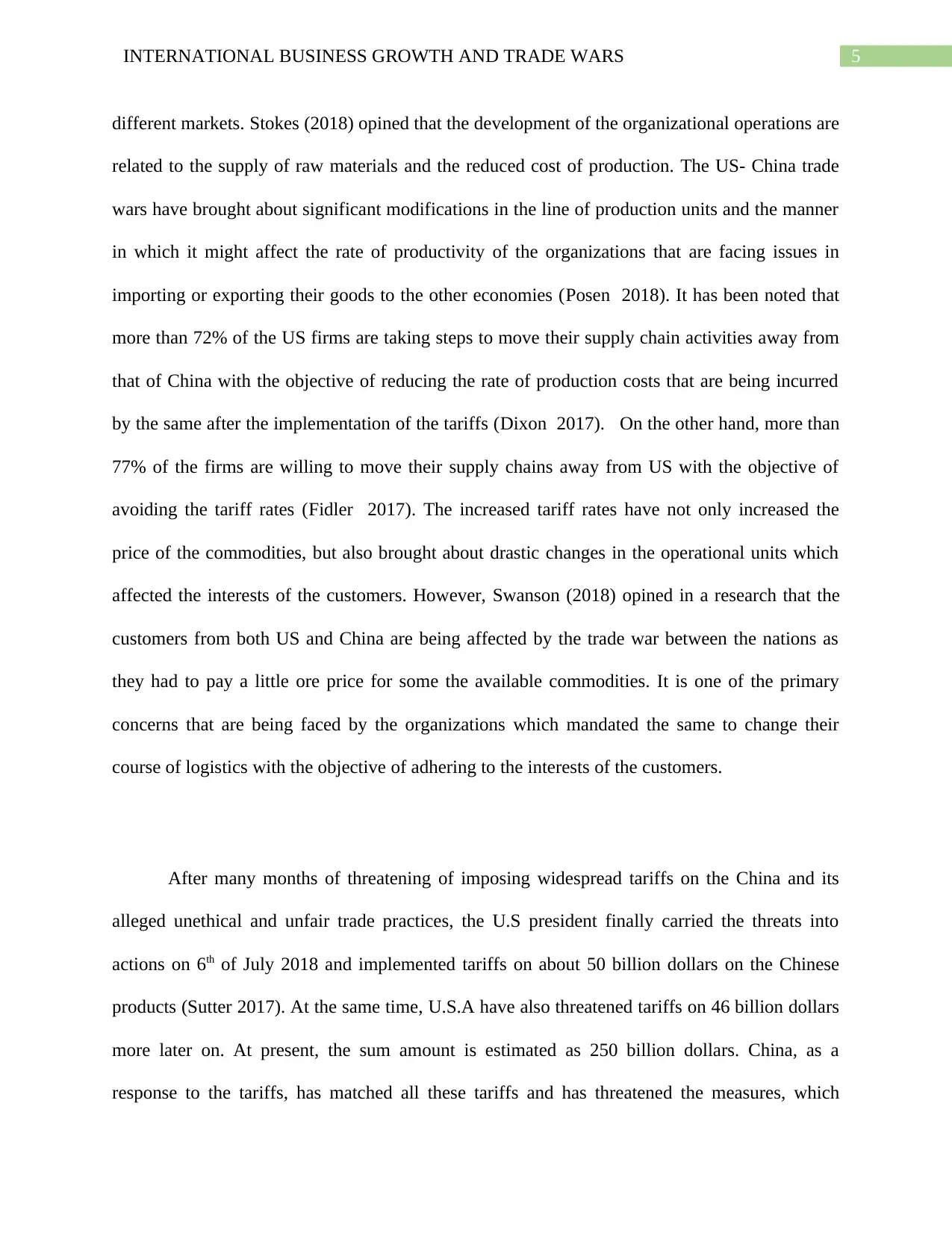
5INTERNATIONAL BUSINESS GROWTH AND TRADE WARS
different markets. Stokes (2018) opined that the development of the organizational operations are
related to the supply of raw materials and the reduced cost of production. The US- China trade
wars have brought about significant modifications in the line of production units and the manner
in which it might affect the rate of productivity of the organizations that are facing issues in
importing or exporting their goods to the other economies (Posen 2018). It has been noted that
more than 72% of the US firms are taking steps to move their supply chain activities away from
that of China with the objective of reducing the rate of production costs that are being incurred
by the same after the implementation of the tariffs (Dixon 2017). On the other hand, more than
77% of the firms are willing to move their supply chains away from US with the objective of
avoiding the tariff rates (Fidler 2017). The increased tariff rates have not only increased the
price of the commodities, but also brought about drastic changes in the operational units which
affected the interests of the customers. However, Swanson (2018) opined in a research that the
customers from both US and China are being affected by the trade war between the nations as
they had to pay a little ore price for some the available commodities. It is one of the primary
concerns that are being faced by the organizations which mandated the same to change their
course of logistics with the objective of adhering to the interests of the customers.
After many months of threatening of imposing widespread tariffs on the China and its
alleged unethical and unfair trade practices, the U.S president finally carried the threats into
actions on 6th of July 2018 and implemented tariffs on about 50 billion dollars on the Chinese
products (Sutter 2017). At the same time, U.S.A have also threatened tariffs on 46 billion dollars
more later on. At present, the sum amount is estimated as 250 billion dollars. China, as a
response to the tariffs, has matched all these tariffs and has threatened the measures, which
different markets. Stokes (2018) opined that the development of the organizational operations are
related to the supply of raw materials and the reduced cost of production. The US- China trade
wars have brought about significant modifications in the line of production units and the manner
in which it might affect the rate of productivity of the organizations that are facing issues in
importing or exporting their goods to the other economies (Posen 2018). It has been noted that
more than 72% of the US firms are taking steps to move their supply chain activities away from
that of China with the objective of reducing the rate of production costs that are being incurred
by the same after the implementation of the tariffs (Dixon 2017). On the other hand, more than
77% of the firms are willing to move their supply chains away from US with the objective of
avoiding the tariff rates (Fidler 2017). The increased tariff rates have not only increased the
price of the commodities, but also brought about drastic changes in the operational units which
affected the interests of the customers. However, Swanson (2018) opined in a research that the
customers from both US and China are being affected by the trade war between the nations as
they had to pay a little ore price for some the available commodities. It is one of the primary
concerns that are being faced by the organizations which mandated the same to change their
course of logistics with the objective of adhering to the interests of the customers.
After many months of threatening of imposing widespread tariffs on the China and its
alleged unethical and unfair trade practices, the U.S president finally carried the threats into
actions on 6th of July 2018 and implemented tariffs on about 50 billion dollars on the Chinese
products (Sutter 2017). At the same time, U.S.A have also threatened tariffs on 46 billion dollars
more later on. At present, the sum amount is estimated as 250 billion dollars. China, as a
response to the tariffs, has matched all these tariffs and has threatened the measures, which
⊘ This is a preview!⊘
Do you want full access?
Subscribe today to unlock all pages.

Trusted by 1+ million students worldwide
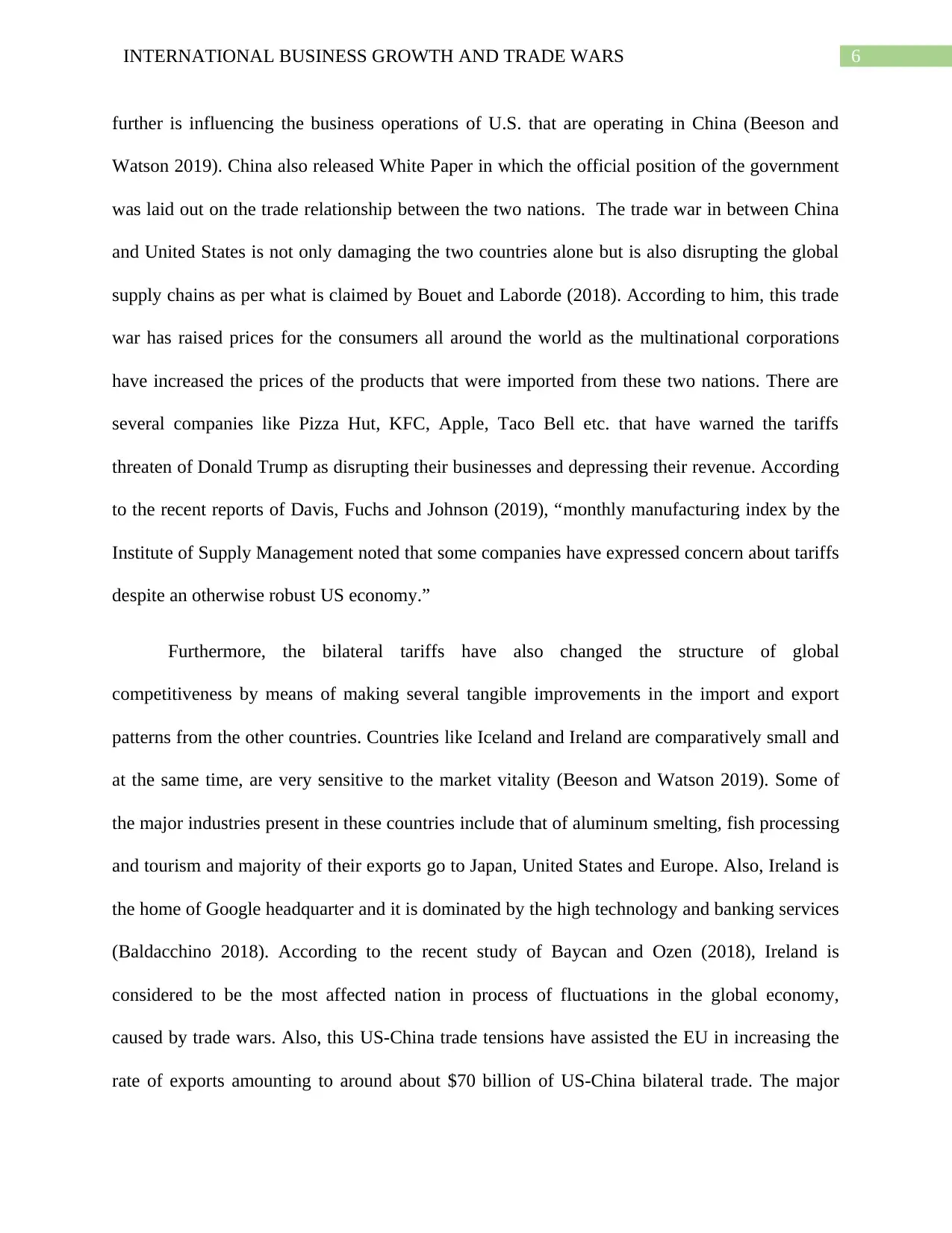
6INTERNATIONAL BUSINESS GROWTH AND TRADE WARS
further is influencing the business operations of U.S. that are operating in China (Beeson and
Watson 2019). China also released White Paper in which the official position of the government
was laid out on the trade relationship between the two nations. The trade war in between China
and United States is not only damaging the two countries alone but is also disrupting the global
supply chains as per what is claimed by Bouet and Laborde (2018). According to him, this trade
war has raised prices for the consumers all around the world as the multinational corporations
have increased the prices of the products that were imported from these two nations. There are
several companies like Pizza Hut, KFC, Apple, Taco Bell etc. that have warned the tariffs
threaten of Donald Trump as disrupting their businesses and depressing their revenue. According
to the recent reports of Davis, Fuchs and Johnson (2019), “monthly manufacturing index by the
Institute of Supply Management noted that some companies have expressed concern about tariffs
despite an otherwise robust US economy.”
Furthermore, the bilateral tariffs have also changed the structure of global
competitiveness by means of making several tangible improvements in the import and export
patterns from the other countries. Countries like Iceland and Ireland are comparatively small and
at the same time, are very sensitive to the market vitality (Beeson and Watson 2019). Some of
the major industries present in these countries include that of aluminum smelting, fish processing
and tourism and majority of their exports go to Japan, United States and Europe. Also, Ireland is
the home of Google headquarter and it is dominated by the high technology and banking services
(Baldacchino 2018). According to the recent study of Baycan and Ozen (2018), Ireland is
considered to be the most affected nation in process of fluctuations in the global economy,
caused by trade wars. Also, this US-China trade tensions have assisted the EU in increasing the
rate of exports amounting to around about $70 billion of US-China bilateral trade. The major
further is influencing the business operations of U.S. that are operating in China (Beeson and
Watson 2019). China also released White Paper in which the official position of the government
was laid out on the trade relationship between the two nations. The trade war in between China
and United States is not only damaging the two countries alone but is also disrupting the global
supply chains as per what is claimed by Bouet and Laborde (2018). According to him, this trade
war has raised prices for the consumers all around the world as the multinational corporations
have increased the prices of the products that were imported from these two nations. There are
several companies like Pizza Hut, KFC, Apple, Taco Bell etc. that have warned the tariffs
threaten of Donald Trump as disrupting their businesses and depressing their revenue. According
to the recent reports of Davis, Fuchs and Johnson (2019), “monthly manufacturing index by the
Institute of Supply Management noted that some companies have expressed concern about tariffs
despite an otherwise robust US economy.”
Furthermore, the bilateral tariffs have also changed the structure of global
competitiveness by means of making several tangible improvements in the import and export
patterns from the other countries. Countries like Iceland and Ireland are comparatively small and
at the same time, are very sensitive to the market vitality (Beeson and Watson 2019). Some of
the major industries present in these countries include that of aluminum smelting, fish processing
and tourism and majority of their exports go to Japan, United States and Europe. Also, Ireland is
the home of Google headquarter and it is dominated by the high technology and banking services
(Baldacchino 2018). According to the recent study of Baycan and Ozen (2018), Ireland is
considered to be the most affected nation in process of fluctuations in the global economy,
caused by trade wars. Also, this US-China trade tensions have assisted the EU in increasing the
rate of exports amounting to around about $70 billion of US-China bilateral trade. The major
Paraphrase This Document
Need a fresh take? Get an instant paraphrase of this document with our AI Paraphraser
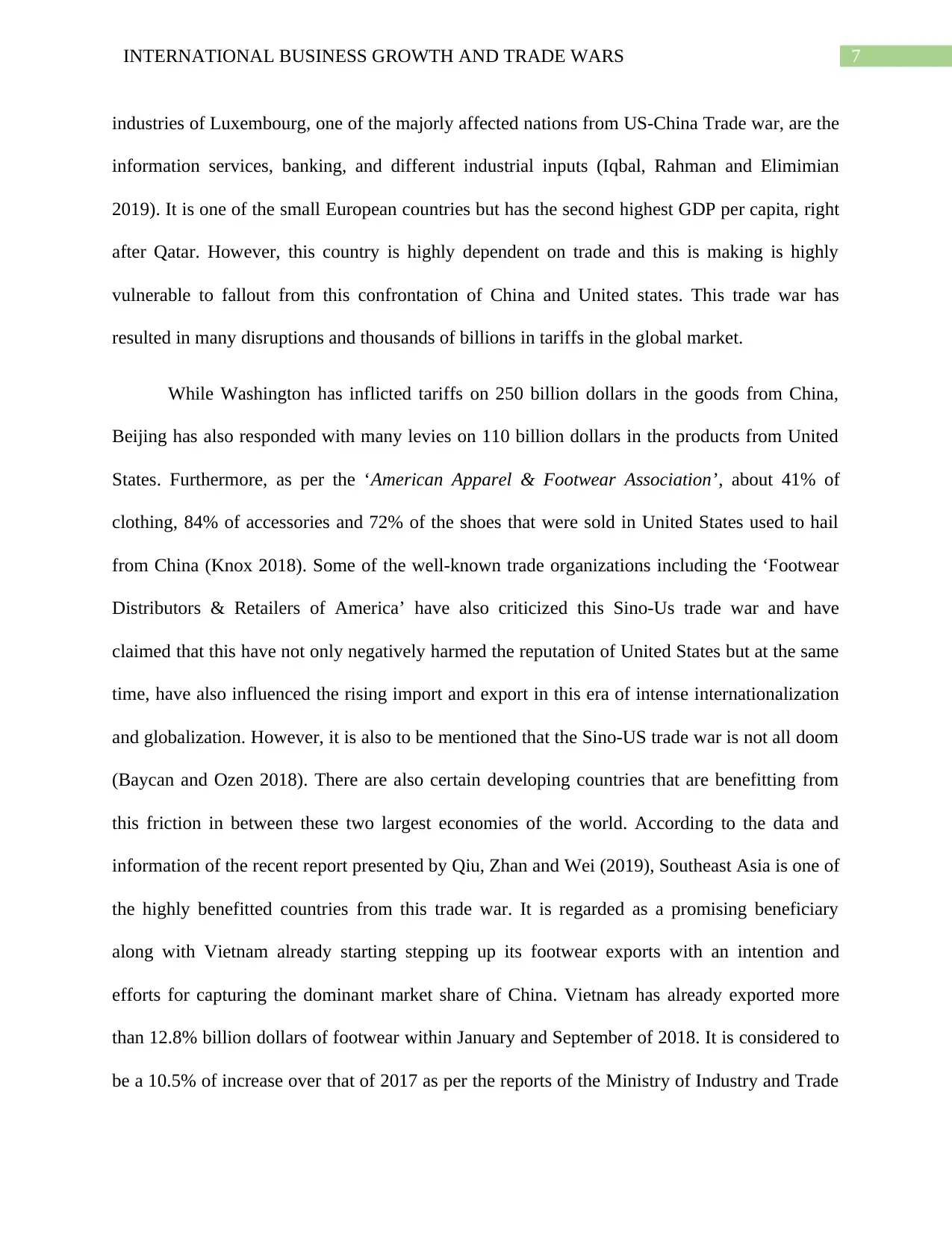
7INTERNATIONAL BUSINESS GROWTH AND TRADE WARS
industries of Luxembourg, one of the majorly affected nations from US-China Trade war, are the
information services, banking, and different industrial inputs (Iqbal, Rahman and Elimimian
2019). It is one of the small European countries but has the second highest GDP per capita, right
after Qatar. However, this country is highly dependent on trade and this is making is highly
vulnerable to fallout from this confrontation of China and United states. This trade war has
resulted in many disruptions and thousands of billions in tariffs in the global market.
While Washington has inflicted tariffs on 250 billion dollars in the goods from China,
Beijing has also responded with many levies on 110 billion dollars in the products from United
States. Furthermore, as per the ‘American Apparel & Footwear Association’, about 41% of
clothing, 84% of accessories and 72% of the shoes that were sold in United States used to hail
from China (Knox 2018). Some of the well-known trade organizations including the ‘Footwear
Distributors & Retailers of America’ have also criticized this Sino-Us trade war and have
claimed that this have not only negatively harmed the reputation of United States but at the same
time, have also influenced the rising import and export in this era of intense internationalization
and globalization. However, it is also to be mentioned that the Sino-US trade war is not all doom
(Baycan and Ozen 2018). There are also certain developing countries that are benefitting from
this friction in between these two largest economies of the world. According to the data and
information of the recent report presented by Qiu, Zhan and Wei (2019), Southeast Asia is one of
the highly benefitted countries from this trade war. It is regarded as a promising beneficiary
along with Vietnam already starting stepping up its footwear exports with an intention and
efforts for capturing the dominant market share of China. Vietnam has already exported more
than 12.8% billion dollars of footwear within January and September of 2018. It is considered to
be a 10.5% of increase over that of 2017 as per the reports of the Ministry of Industry and Trade
industries of Luxembourg, one of the majorly affected nations from US-China Trade war, are the
information services, banking, and different industrial inputs (Iqbal, Rahman and Elimimian
2019). It is one of the small European countries but has the second highest GDP per capita, right
after Qatar. However, this country is highly dependent on trade and this is making is highly
vulnerable to fallout from this confrontation of China and United states. This trade war has
resulted in many disruptions and thousands of billions in tariffs in the global market.
While Washington has inflicted tariffs on 250 billion dollars in the goods from China,
Beijing has also responded with many levies on 110 billion dollars in the products from United
States. Furthermore, as per the ‘American Apparel & Footwear Association’, about 41% of
clothing, 84% of accessories and 72% of the shoes that were sold in United States used to hail
from China (Knox 2018). Some of the well-known trade organizations including the ‘Footwear
Distributors & Retailers of America’ have also criticized this Sino-Us trade war and have
claimed that this have not only negatively harmed the reputation of United States but at the same
time, have also influenced the rising import and export in this era of intense internationalization
and globalization. However, it is also to be mentioned that the Sino-US trade war is not all doom
(Baycan and Ozen 2018). There are also certain developing countries that are benefitting from
this friction in between these two largest economies of the world. According to the data and
information of the recent report presented by Qiu, Zhan and Wei (2019), Southeast Asia is one of
the highly benefitted countries from this trade war. It is regarded as a promising beneficiary
along with Vietnam already starting stepping up its footwear exports with an intention and
efforts for capturing the dominant market share of China. Vietnam has already exported more
than 12.8% billion dollars of footwear within January and September of 2018. It is considered to
be a 10.5% of increase over that of 2017 as per the reports of the Ministry of Industry and Trade
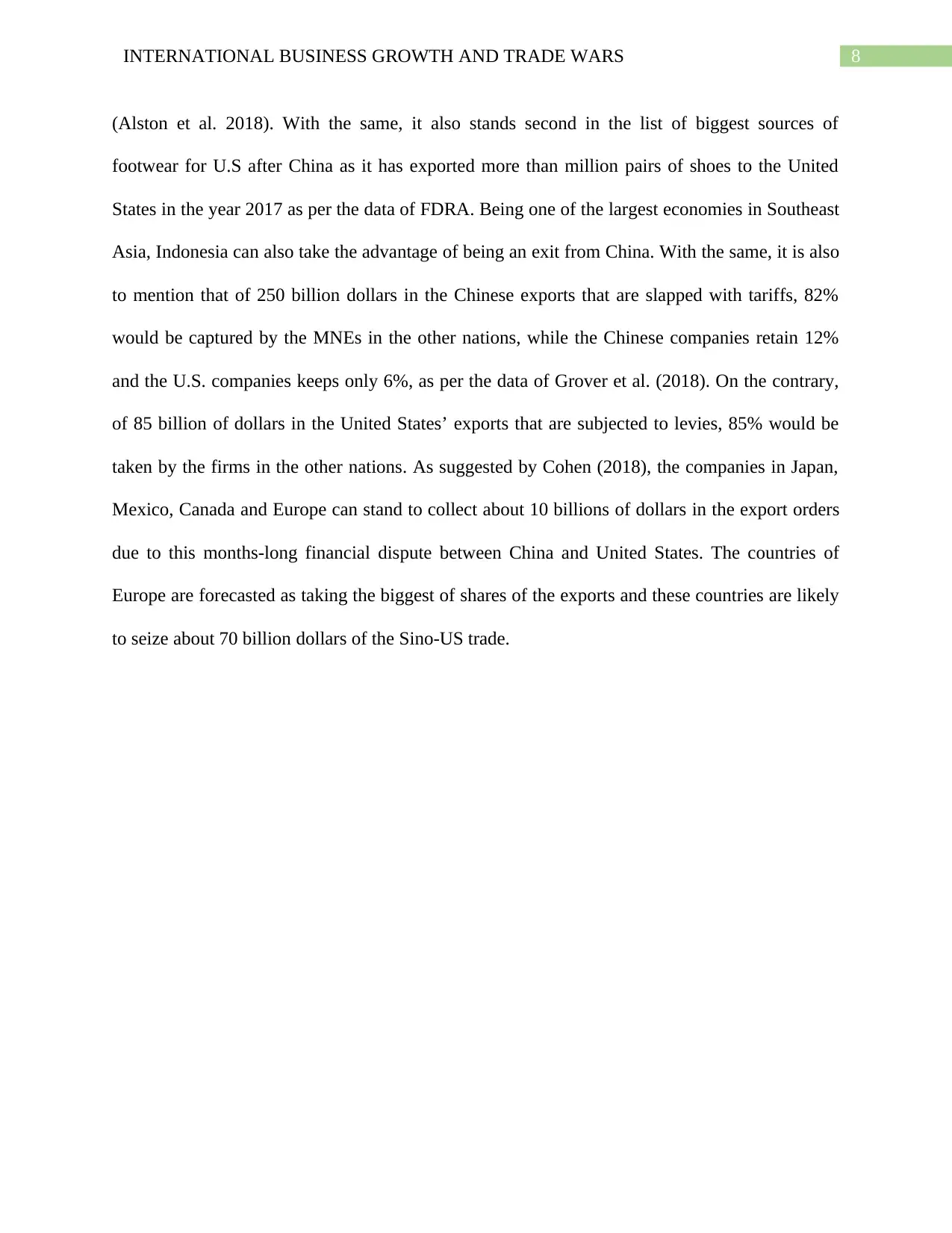
8INTERNATIONAL BUSINESS GROWTH AND TRADE WARS
(Alston et al. 2018). With the same, it also stands second in the list of biggest sources of
footwear for U.S after China as it has exported more than million pairs of shoes to the United
States in the year 2017 as per the data of FDRA. Being one of the largest economies in Southeast
Asia, Indonesia can also take the advantage of being an exit from China. With the same, it is also
to mention that of 250 billion dollars in the Chinese exports that are slapped with tariffs, 82%
would be captured by the MNEs in the other nations, while the Chinese companies retain 12%
and the U.S. companies keeps only 6%, as per the data of Grover et al. (2018). On the contrary,
of 85 billion of dollars in the United States’ exports that are subjected to levies, 85% would be
taken by the firms in the other nations. As suggested by Cohen (2018), the companies in Japan,
Mexico, Canada and Europe can stand to collect about 10 billions of dollars in the export orders
due to this months-long financial dispute between China and United States. The countries of
Europe are forecasted as taking the biggest of shares of the exports and these countries are likely
to seize about 70 billion dollars of the Sino-US trade.
(Alston et al. 2018). With the same, it also stands second in the list of biggest sources of
footwear for U.S after China as it has exported more than million pairs of shoes to the United
States in the year 2017 as per the data of FDRA. Being one of the largest economies in Southeast
Asia, Indonesia can also take the advantage of being an exit from China. With the same, it is also
to mention that of 250 billion dollars in the Chinese exports that are slapped with tariffs, 82%
would be captured by the MNEs in the other nations, while the Chinese companies retain 12%
and the U.S. companies keeps only 6%, as per the data of Grover et al. (2018). On the contrary,
of 85 billion of dollars in the United States’ exports that are subjected to levies, 85% would be
taken by the firms in the other nations. As suggested by Cohen (2018), the companies in Japan,
Mexico, Canada and Europe can stand to collect about 10 billions of dollars in the export orders
due to this months-long financial dispute between China and United States. The countries of
Europe are forecasted as taking the biggest of shares of the exports and these countries are likely
to seize about 70 billion dollars of the Sino-US trade.
⊘ This is a preview!⊘
Do you want full access?
Subscribe today to unlock all pages.

Trusted by 1+ million students worldwide
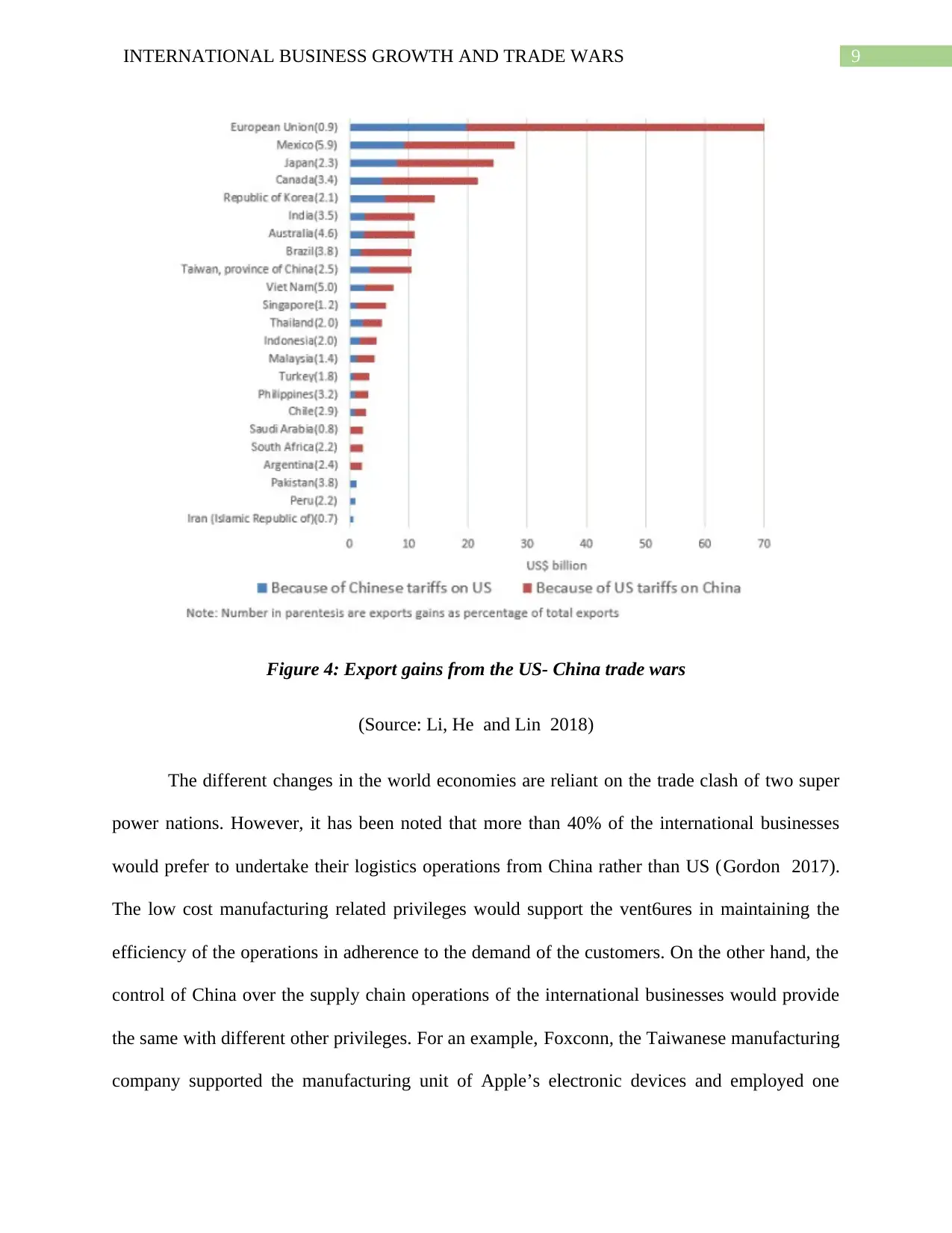
9INTERNATIONAL BUSINESS GROWTH AND TRADE WARS
Figure 4: Export gains from the US- China trade wars
(Source: Li, He and Lin 2018)
The different changes in the world economies are reliant on the trade clash of two super
power nations. However, it has been noted that more than 40% of the international businesses
would prefer to undertake their logistics operations from China rather than US (Gordon 2017).
The low cost manufacturing related privileges would support the vent6ures in maintaining the
efficiency of the operations in adherence to the demand of the customers. On the other hand, the
control of China over the supply chain operations of the international businesses would provide
the same with different other privileges. For an example, Foxconn, the Taiwanese manufacturing
company supported the manufacturing unit of Apple’s electronic devices and employed one
Figure 4: Export gains from the US- China trade wars
(Source: Li, He and Lin 2018)
The different changes in the world economies are reliant on the trade clash of two super
power nations. However, it has been noted that more than 40% of the international businesses
would prefer to undertake their logistics operations from China rather than US (Gordon 2017).
The low cost manufacturing related privileges would support the vent6ures in maintaining the
efficiency of the operations in adherence to the demand of the customers. On the other hand, the
control of China over the supply chain operations of the international businesses would provide
the same with different other privileges. For an example, Foxconn, the Taiwanese manufacturing
company supported the manufacturing unit of Apple’s electronic devices and employed one
Paraphrase This Document
Need a fresh take? Get an instant paraphrase of this document with our AI Paraphraser
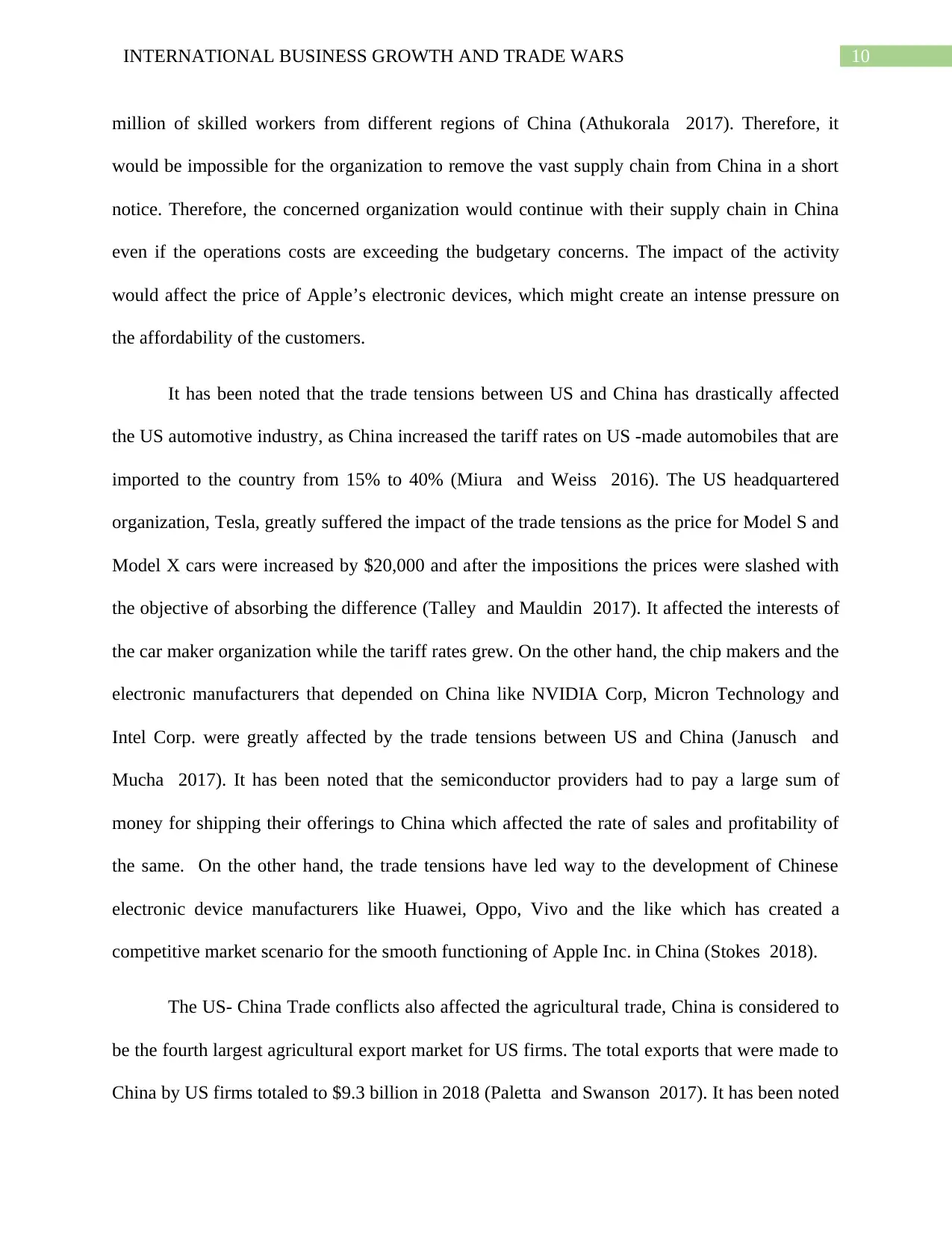
10INTERNATIONAL BUSINESS GROWTH AND TRADE WARS
million of skilled workers from different regions of China (Athukorala 2017). Therefore, it
would be impossible for the organization to remove the vast supply chain from China in a short
notice. Therefore, the concerned organization would continue with their supply chain in China
even if the operations costs are exceeding the budgetary concerns. The impact of the activity
would affect the price of Apple’s electronic devices, which might create an intense pressure on
the affordability of the customers.
It has been noted that the trade tensions between US and China has drastically affected
the US automotive industry, as China increased the tariff rates on US -made automobiles that are
imported to the country from 15% to 40% (Miura and Weiss 2016). The US headquartered
organization, Tesla, greatly suffered the impact of the trade tensions as the price for Model S and
Model X cars were increased by $20,000 and after the impositions the prices were slashed with
the objective of absorbing the difference (Talley and Mauldin 2017). It affected the interests of
the car maker organization while the tariff rates grew. On the other hand, the chip makers and the
electronic manufacturers that depended on China like NVIDIA Corp, Micron Technology and
Intel Corp. were greatly affected by the trade tensions between US and China (Janusch and
Mucha 2017). It has been noted that the semiconductor providers had to pay a large sum of
money for shipping their offerings to China which affected the rate of sales and profitability of
the same. On the other hand, the trade tensions have led way to the development of Chinese
electronic device manufacturers like Huawei, Oppo, Vivo and the like which has created a
competitive market scenario for the smooth functioning of Apple Inc. in China (Stokes 2018).
The US- China Trade conflicts also affected the agricultural trade, China is considered to
be the fourth largest agricultural export market for US firms. The total exports that were made to
China by US firms totaled to $9.3 billion in 2018 (Paletta and Swanson 2017). It has been noted
million of skilled workers from different regions of China (Athukorala 2017). Therefore, it
would be impossible for the organization to remove the vast supply chain from China in a short
notice. Therefore, the concerned organization would continue with their supply chain in China
even if the operations costs are exceeding the budgetary concerns. The impact of the activity
would affect the price of Apple’s electronic devices, which might create an intense pressure on
the affordability of the customers.
It has been noted that the trade tensions between US and China has drastically affected
the US automotive industry, as China increased the tariff rates on US -made automobiles that are
imported to the country from 15% to 40% (Miura and Weiss 2016). The US headquartered
organization, Tesla, greatly suffered the impact of the trade tensions as the price for Model S and
Model X cars were increased by $20,000 and after the impositions the prices were slashed with
the objective of absorbing the difference (Talley and Mauldin 2017). It affected the interests of
the car maker organization while the tariff rates grew. On the other hand, the chip makers and the
electronic manufacturers that depended on China like NVIDIA Corp, Micron Technology and
Intel Corp. were greatly affected by the trade tensions between US and China (Janusch and
Mucha 2017). It has been noted that the semiconductor providers had to pay a large sum of
money for shipping their offerings to China which affected the rate of sales and profitability of
the same. On the other hand, the trade tensions have led way to the development of Chinese
electronic device manufacturers like Huawei, Oppo, Vivo and the like which has created a
competitive market scenario for the smooth functioning of Apple Inc. in China (Stokes 2018).
The US- China Trade conflicts also affected the agricultural trade, China is considered to
be the fourth largest agricultural export market for US firms. The total exports that were made to
China by US firms totaled to $9.3 billion in 2018 (Paletta and Swanson 2017). It has been noted
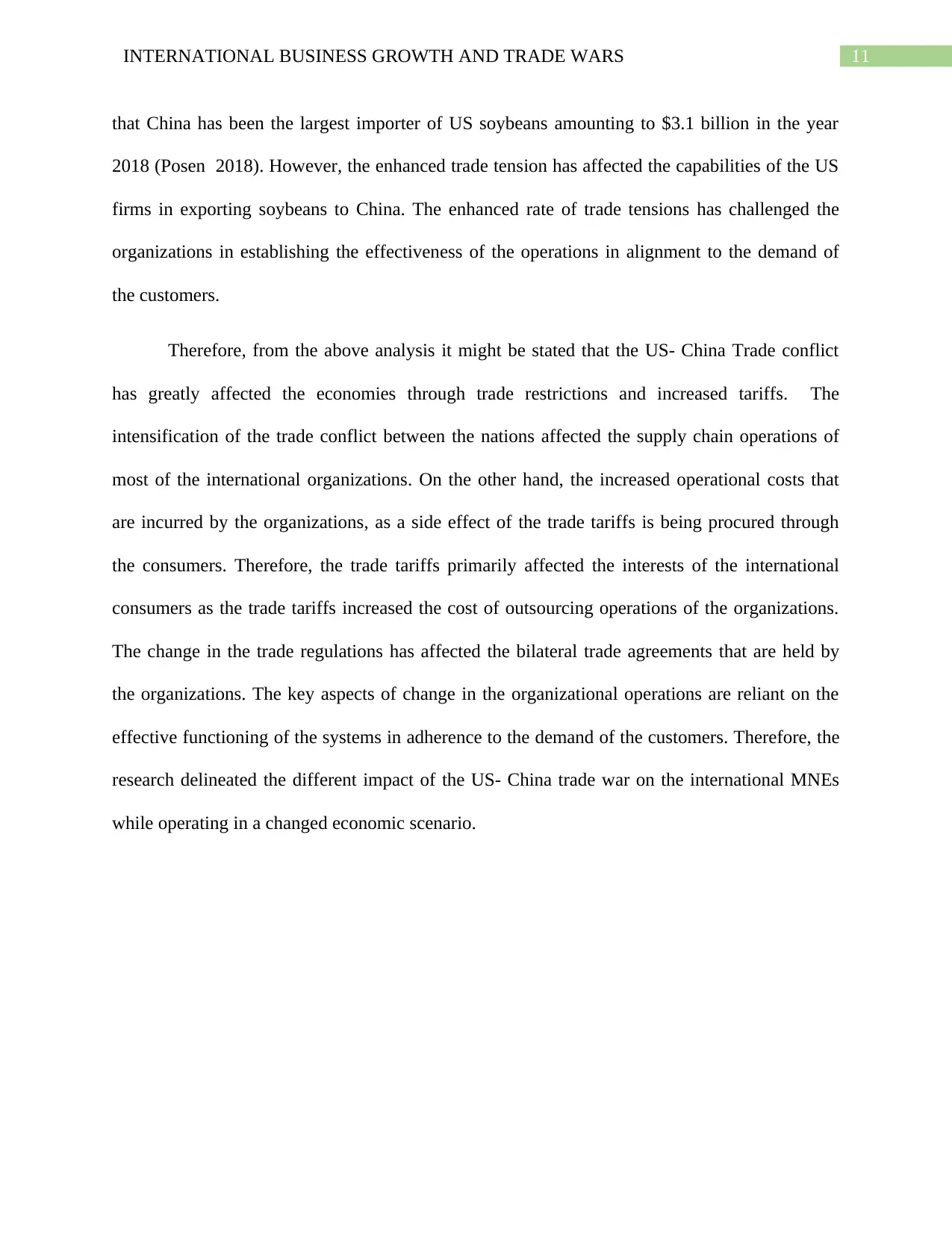
11INTERNATIONAL BUSINESS GROWTH AND TRADE WARS
that China has been the largest importer of US soybeans amounting to $3.1 billion in the year
2018 (Posen 2018). However, the enhanced trade tension has affected the capabilities of the US
firms in exporting soybeans to China. The enhanced rate of trade tensions has challenged the
organizations in establishing the effectiveness of the operations in alignment to the demand of
the customers.
Therefore, from the above analysis it might be stated that the US- China Trade conflict
has greatly affected the economies through trade restrictions and increased tariffs. The
intensification of the trade conflict between the nations affected the supply chain operations of
most of the international organizations. On the other hand, the increased operational costs that
are incurred by the organizations, as a side effect of the trade tariffs is being procured through
the consumers. Therefore, the trade tariffs primarily affected the interests of the international
consumers as the trade tariffs increased the cost of outsourcing operations of the organizations.
The change in the trade regulations has affected the bilateral trade agreements that are held by
the organizations. The key aspects of change in the organizational operations are reliant on the
effective functioning of the systems in adherence to the demand of the customers. Therefore, the
research delineated the different impact of the US- China trade war on the international MNEs
while operating in a changed economic scenario.
that China has been the largest importer of US soybeans amounting to $3.1 billion in the year
2018 (Posen 2018). However, the enhanced trade tension has affected the capabilities of the US
firms in exporting soybeans to China. The enhanced rate of trade tensions has challenged the
organizations in establishing the effectiveness of the operations in alignment to the demand of
the customers.
Therefore, from the above analysis it might be stated that the US- China Trade conflict
has greatly affected the economies through trade restrictions and increased tariffs. The
intensification of the trade conflict between the nations affected the supply chain operations of
most of the international organizations. On the other hand, the increased operational costs that
are incurred by the organizations, as a side effect of the trade tariffs is being procured through
the consumers. Therefore, the trade tariffs primarily affected the interests of the international
consumers as the trade tariffs increased the cost of outsourcing operations of the organizations.
The change in the trade regulations has affected the bilateral trade agreements that are held by
the organizations. The key aspects of change in the organizational operations are reliant on the
effective functioning of the systems in adherence to the demand of the customers. Therefore, the
research delineated the different impact of the US- China trade war on the international MNEs
while operating in a changed economic scenario.
⊘ This is a preview!⊘
Do you want full access?
Subscribe today to unlock all pages.

Trusted by 1+ million students worldwide
1 out of 16
Related Documents
Your All-in-One AI-Powered Toolkit for Academic Success.
+13062052269
info@desklib.com
Available 24*7 on WhatsApp / Email
![[object Object]](/_next/static/media/star-bottom.7253800d.svg)
Unlock your academic potential
Copyright © 2020–2025 A2Z Services. All Rights Reserved. Developed and managed by ZUCOL.





